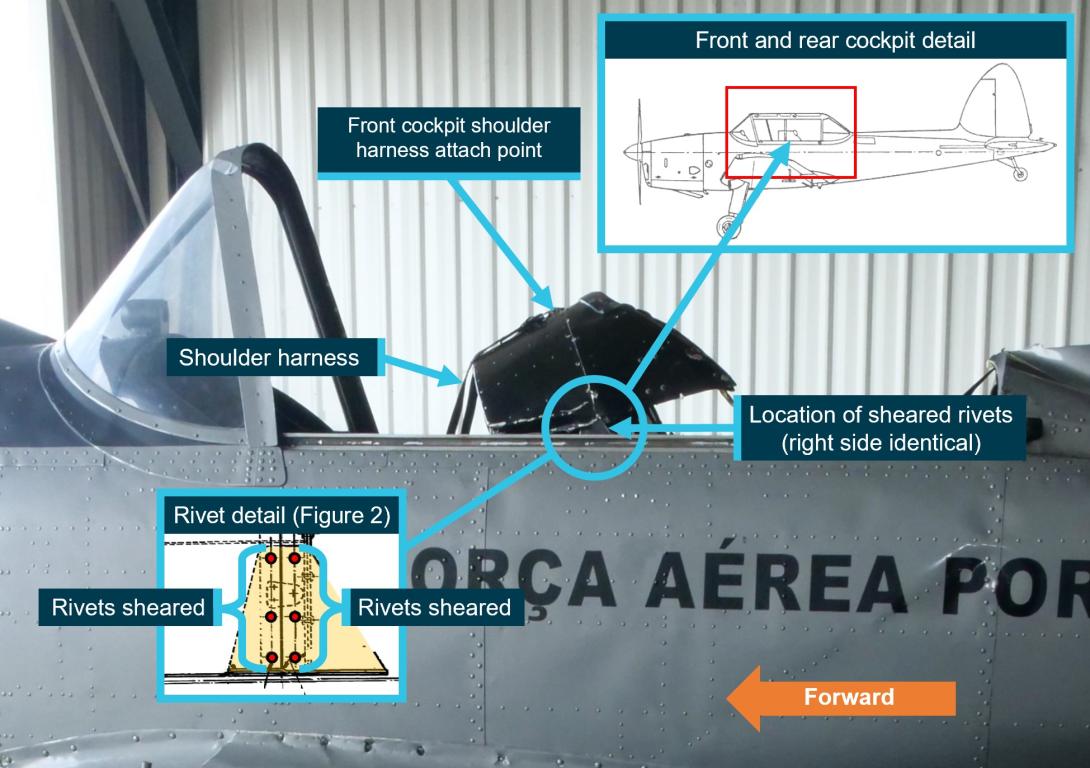Safety Advisory Notice
To DHC-1 Chipmunk maintainers and owners
Crashworthiness of some DHC-1 Chipmunks may be compromised by incorrect specification rivets.
What happened
On the afternoon of 26 April 2024, the pilot of a DHC‑1 Chipmunk took off from Jandakot Airport, Western Australia. The engine cowling on the left side had not been fastened prior to take-off and began to open and close in flight. The aircraft turned to the left at low height near the end of the runway, with an increasing angle of bank, before descending and colliding with terrain. The pilot was transported to hospital and later succumbed to injuries.
What increased risk
The DHC-1 Chipmunk is a low-wing aircraft designed for military flight training. It has 2 seats that are arranged in tandem (one cockpit behind the other). The front cockpit shoulder harness is attached to the upper structure between the front and rear cockpits.
The ATSB found that on impact the upper structure between the front and rear cockpits, corresponding to the attach point for the front cockpit shoulder harness, was torn away from its mountings. Most noteworthy, all 12 rivets (6 per side) that attached the structure to the mountings had sheared (Figure 1).
Figure 1: Location of sheared rivets

Image source: ATSB, de Havilland Support Ltd, annotated by the ATSB.
The 2 mountings, called gussets, were installed as modification H.268. This modification was issued by Hawker Siddeley in 1966 to replace the original aluminium alloy gussets with high‑tensile steel. The modification required the forward row of rivets attaching the structure to the gussets to be part number SP85 mushroom head rivets, and the rear row to be part number AS2230 countersunk rivets (Figure 2).
Figure 2: Rivet detail

Image source: ATSB, de Havilland Support Ltd, annotated by the ATSB.
Both part number SP85 and AS2230 rivets were required to be manufactured to British standard L.86, which was an aluminium alloy that included copper and magnesium (with international equivalences of Alloy Designation 2117, US specification AMS7222, and European specification ENAW-AlCu2.5Mg). The standard also specified that the rivets were to be anodised (a surface treatment) and coloured violet.
The sheared rivets were examined by the ATSB using metallurgical equipment and it was determined that:
- The rear row of countersunk rivets appeared to be pure or near-pure aluminium and therefore the incorrect specification. Testing indicated a significant reduction in strength (estimated to be about one-third of the specification strength).
- The forward row of mushroom head rivets appeared to be an alloy consistent with L.86. The rivets were coated with a gold-coloured chromate conversion coating instead of violet anodising. ATSB testing indicated that the strength of the rivets met or exceeded literature values for L.86 alloy.
The ATSB has not determined when or where modification H.268 was embodied, or whether the rivets had been replaced since the modification.
The presence of the non-conforming rivets significantly reduced the integrity of the structure retaining the front cockpit restraint, and thereby compromised the crashworthiness of the aircraft. This non-conforming modification may be present in other Chipmunk aircraft, in which case it would likely affect survivability in an accident.
Crashworthiness design
One element of aircraft crashworthiness is the ability of a restraint system to restrain the occupant within the aircraft’s ‘living space’ throughout a crash. The use of upper torso restraints such as a shoulder harness can further prevent the occupant from striking the surrounding structure during an accident. All components forming part of the restraint system (including the structures to which they are attached) need to be to defined specifications.
Safety advisory notice
AO-2024-013-SAN-01: The ATSB advises DHC‑1 Chipmunk maintainers and owners to be aware that fitment of incorrect specification rivets where the upper structure between the front and rear cockpits attaches to the gussets on either side could significantly compromise the crashworthiness of the aircraft.
Those conducting work on aircraft must ensure modifications are carried out to the required specification, or during maintenance returned to that specification.
Read more about this ATSB investigation: Collision with terrain involving Oficinas Gerais de Material Aeronautico DHC-1 MK 22 Chipmunk, VH-POR, at Jandakot Airport, Western Australia, on 26 April 2024


